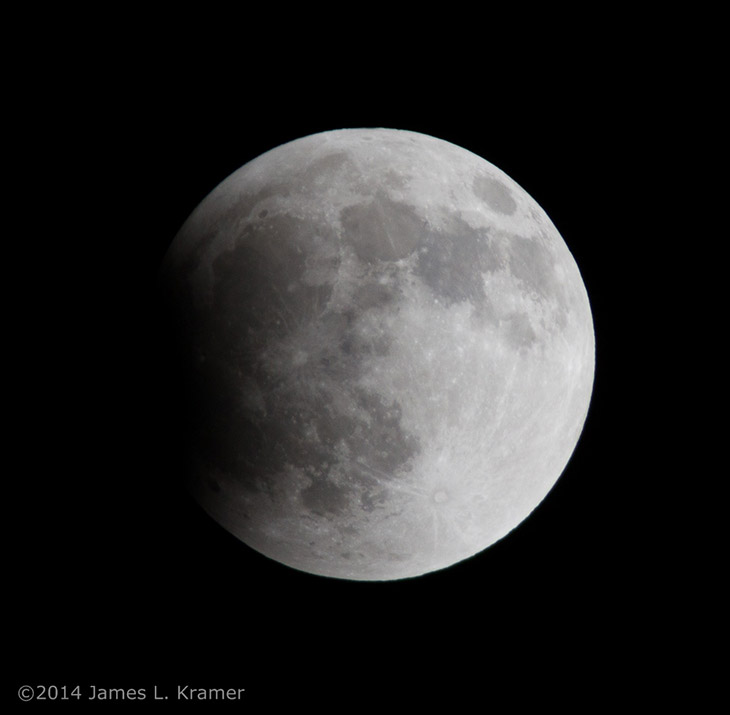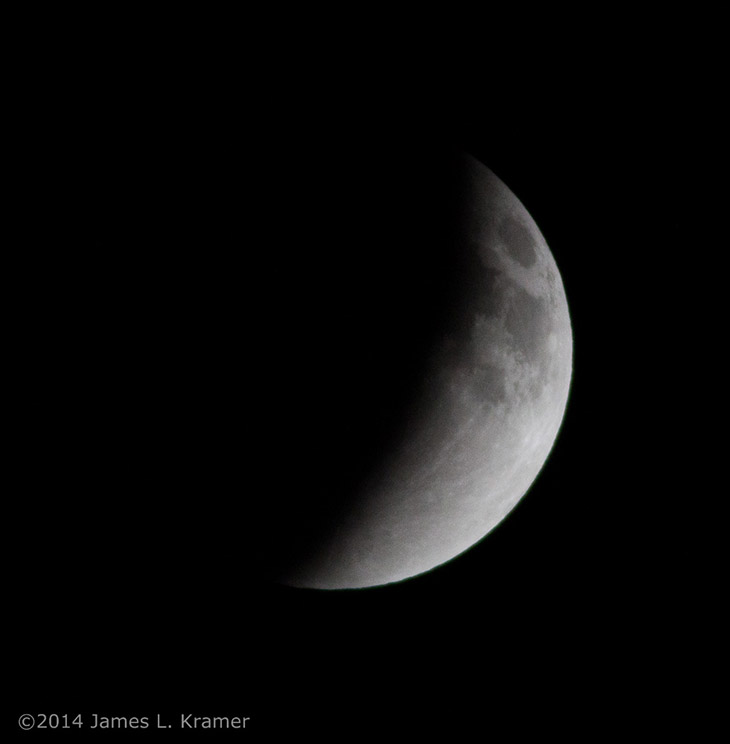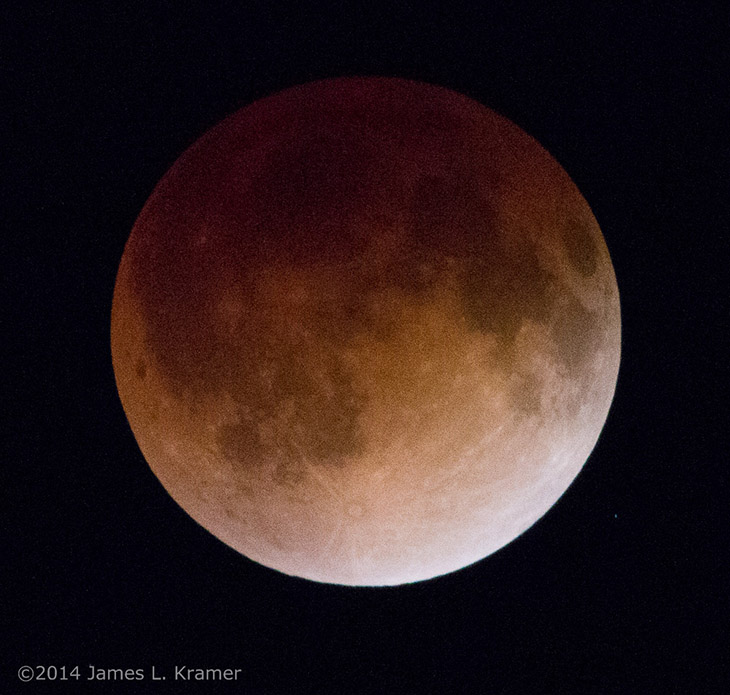I was aware of the total lunar eclipse scheduled to appear last night/this morning (there’s that stupid “it changed day in the middle of the night” thing again,) but after a week of clear and accommodating weather, the front pushed in yesterday and we received solid, low overcast skies, meaning the only thing I could see was how many places nearby waste electricity by throwing their lights up towards the clouds.
However, my inbox this morning told me that Jim, at the Kansas branch of the blog, had much better skies. This was unexpected – he’s never up at that time of night. Nevertheless, the images shown here are (almost) all thanks to him, because I negligently allowed the weather to turn sour in central NC. You could put this down to cleaner living if you want, but he’s more of an atheist than I am, if that’s even possible, so it’s up to you to jam that into your worldview somehow.




As a lunar eclipse progresses to this point, the photographer has a choice to make. Normally, different phases of the moon require different exposure times; this is because the sunlight being reflected is coming at different angles, more oblique for the smaller phases like crescents, and the camera meter cannot often be trusted (which is why people trying to get moon pics with automatic settings usually end up with a glaring blob – the exposure meter is reading too much of the dark sky and trying to make that brighter.) With a lunar eclipse, however, the light remains as direct – it’s just getting partially blocked – so exposure times can remain the same… unless you want to capture that cool orange glow.

That glow is sunlight being filtered through the Earth’s atmosphere, exactly as it does at sunrise and sunset. Were we on the moon at this point, we’d be seeing that really cool corona effect of a total solar eclipse, except that it would mostly be orange in color – the Earth blocks the glare of the sun but some peeks through around the edges, going through the atmosphere as it does so. This glow shines on the surface of the moon and reflects back to us, and the moon becomes this rusty color. But quite dim.

The exposure details are as follows:
Image 1. 1/320 second, f9, ISO 160 Image 2. 1/320 second, f16, ISO 800 Image 3. 1/320 second, f11, ISO 800 Image 4. 1/30 second, f9, ISO 6400 Image 5. 1/8 second, f9, ISO 6400 Image 6. 1/3 second, f11, ISO 6400
The change in ISO, to gather as much light as possible, is responsible for the grainy appearance of the latter images. Without it, Jim would have had to use much longer shutter speeds, and the moon would have moved too much in the frame during exposure – the moon and the sun move their own width across the sky in 150 seconds, so exposure times of even a few seconds will produce a blur at this magnification.
The uneven lighting is due to the relative sizes of the Earth and the sun. From our vantage, the sun and the moon are close to identical in size – they both vary slightly due to changes in distance, which produces different solar eclipses depending on what time of year they occur – sometimes the moon cannot fully block out the sun and there’s a ring of light always remaining, called an annular eclipse. This coincidence in apparent size has actually been touted by some desperate religious apologists as evidence of god, who made the bodies this size to put on a show for us graced humans. Seriously. Because, you know, ancient populaces thrown into terror and believing the end times are nigh is always good for a larf…
But from the vantage point of the moon, the Earth is way bigger than the sun, and rarely lines up perfectly square. The uneven lighting is because the sun’s corona shines past more on one side than another. Lunar eclipses also last much longer than solar, partially because of this size disparity, but also because of orbital motion – the moon’s orbit actually travels with the shadow a bit.
 By the way, there’s another form of light that can fall onto the moon, called earthshine, usually visible only with a thin crescent. At such times, the sun is almost behind the moon from our vantage, shining largely on Earth at the same time (meaning the Earth would be gibbous when seen from the moon.) This light is reflected off of the Earth and shines on the night side of the moon, reflected back to us here on the night side of Earth. It is, not surprisingly, quite dim, so exposure times to capture it will almost always result in blowing out the sunlit portions of the moon. The best time to capture this is with as thin a crescent as possible, and the only times to see the moon with a night sky in those phases is right after sunset, or right before sunrise, waxing or waning crescent respectively.
By the way, there’s another form of light that can fall onto the moon, called earthshine, usually visible only with a thin crescent. At such times, the sun is almost behind the moon from our vantage, shining largely on Earth at the same time (meaning the Earth would be gibbous when seen from the moon.) This light is reflected off of the Earth and shines on the night side of the moon, reflected back to us here on the night side of Earth. It is, not surprisingly, quite dim, so exposure times to capture it will almost always result in blowing out the sunlit portions of the moon. The best time to capture this is with as thin a crescent as possible, and the only times to see the moon with a night sky in those phases is right after sunset, or right before sunrise, waxing or waning crescent respectively.
Now, go back up and take a look at that last eclipse photo of Jim’s. See the little blue dot at lower right? Is this a star? Well, putting Jim’s location into Stellarium and rolling it back to the timestamp from the image, I would say yes, it is – HIP 65821, with a magnitude of only 8.35 (that’s typically dimmer than we can see by eye.) The only time we’d be able to make out a star like that this close to the moon is during a total eclipse – otherwise the light scattered through our atmosphere would have obscured it in haze.
And yes, Stellarium even shows the eclipse. Download it and check it out – it’s a great free program.




















































